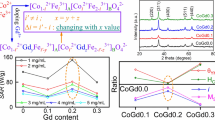Abstract
Three Fe(β-diketonate)3 compounds namely Fe(tmhd)3 (tmhd = 2,2,6,6-tetramethyl-3,5-heptanedionato), Fe(hfac)3 (hfac = hexafluoroacetylaceto), and Fe(dbm)3 (dbm = dibenzoylmethane) were used as substitutes to Fe(acac)3 (acac = acetyleacetonate) in the synthesis of FePt nanoparticles. The obtained superparamagnetic nanoparticles are 4–5 nm in diameter without showing a large size variation with substituent Fe(β-diketonate)3. The synchrotron X-ray absorption spectroscopy confirmed the energy dispersive spectroscopy that as-synthesized nanoparticles were composed of iron oxides and metallic FePt3 alloys. By employing Fe(hfac)3, the Fe fraction was reduced and the magnetization was modest. The use of Fe(dbm)3 as starting materials gave rise to densely packed FePt3/Fe2O3 heterodimers. The replacements of Fe(acac)3 by Fe(tmhd)3 led to the long-range order of nanoparticle assembly with the narrowest size distribution.








Similar content being viewed by others
References
Antoniak C (2011) Extended X-ray absorption fine structure of bimetallic nanoparticles. Beilstein J Nanotechnol 2:237–251
Beck W Jr, Souza CGS, Silva TL, Jafelicci M Jr, Varanda LC (2011) Formation mechanism via a heterocoagulation approach of FePt nanoparticles using the modified polyol process. J Phys Chem C 115:10475–10482
Bishop KJM, Wilmer CE, Soh S, Grzybowski BA (2009) Nanoscale forces and their uses in self-assembly. Small 5:1600–1630
Chokprasombat K, Sirisathitkul C, Harding P, Chandarak S, Yimnirun R (2013) Monodisperse magnetic nanoparticles: Effects of surfactants on the reaction between iron acetylacetonate and platinum acetylacetonate. Rev Mex Fis 59:224–228
Chokprasombat K, Sirisathitkul C, Ratphonsan P (2014) Liquid-air interface self-assembly: a facile method to fabricate long-range nanoparticle monolayers. Surf Sci 621:162–167
Farahmandjou M (2013) Comparison of the Fe and Pt nanoparticles with FePt alloy prepared by polyol process: shape and composition study. Acta Phys Pol A 123:277–278
Figueroa SJA, Stewart SJ, Rueda T, Hernando A, de la Presa P (2011) Thermal evolution of Pt-rich FePt/Fe3O4 heterodimers studied using X-ray absorption near-edge spectroscopy. J Phys Chem C 115:5500–5508
Hsieh SC, Lin PY (2012) FePt nanoparticles as heterogeneous fenton-like catalysts for hydrogen peroxide decomposition and the decolorization of methylene blue. J Nanopart Res 14:956
Jia Z, Misra RDK (2008) Self-assembled magnetic nanostructures. Mater Technol 23:66–80
Medwal R, Sehdev N, Annapoorni S (2013) Temperature-dependent magnetic and structural ordering of self-assembled magnetic array of FePt nanoparticles. J Nanopart Res 15:1423
Muneesawang P, Sirisathitkul Y, Sirisathitkul C (2014) Multi-level segmentation procedure for measuring the size distribution of nanoparticles in TEM images. Sci Adv Mater 6 (in press)
Nandurkar NS, Patil DS, Bhanage BM (2008) Ultrasound assisted synthesis of metal-1,3-diketonates. Inorg Chem Commun 11:733–736
Poudyal N, Liu JP (2013) Advances in nanostructured permanent magnets research. J Phys D Appl Phys 46:043001
Ravel B, Newville M (2005) ATHENA, ARTEMIS, HEPHAESTUS: data analysis for X-ray absorption spectroscopy using IFEFFIT. J Synchrotron Radiat 12:537–541
Sun S (2006) Recent advances in chemical synthesis, self assembly, and applications of FePt nanoparticles. Adv Mater 18:393–403
Sun S, Murray CB, Weller D, Folks L, Moser A (2000) Monodisperse FePt nanoparticles and ferromagnetic FePt nanocrystal superlattices. Science 287:1989–1992
Wang JP (2008) FePt magnetic nanoparticles and their assembly for future magnetic media. Proc IEEE 11:1847–1863
Acknowledgments
This work is financially funded by the Industry/University Cooperative Research Center (I/UCRC) in HDD Component, the Faculty of Engineering, Khon Kaen University and National Electronics and Computer Technology Center, National Science and Technology Development Agency with the approval of Seagate Technology (Thailand). We are grateful to Prof. Dr. Thomas Randall Lee of University of Houston for his guidance and facility support. The characterization by XAS and TEM was accomplished with the assistance by the staff at Synchrotron Light Research Institute and Khon Kaen University, respectively.
Author information
Authors and Affiliations
Corresponding author
Rights and permissions
About this article
Cite this article
Chokprasombat, K., Harding, P., Sirisathitkul, C. et al. Substituent effect of Fe(β-diketonate)3 on the control of self-assembly FePt-based nanoparticles. J Nanopart Res 16, 2436 (2014). https://doi.org/10.1007/s11051-014-2436-9
Received:
Accepted:
Published:
DOI: https://doi.org/10.1007/s11051-014-2436-9




